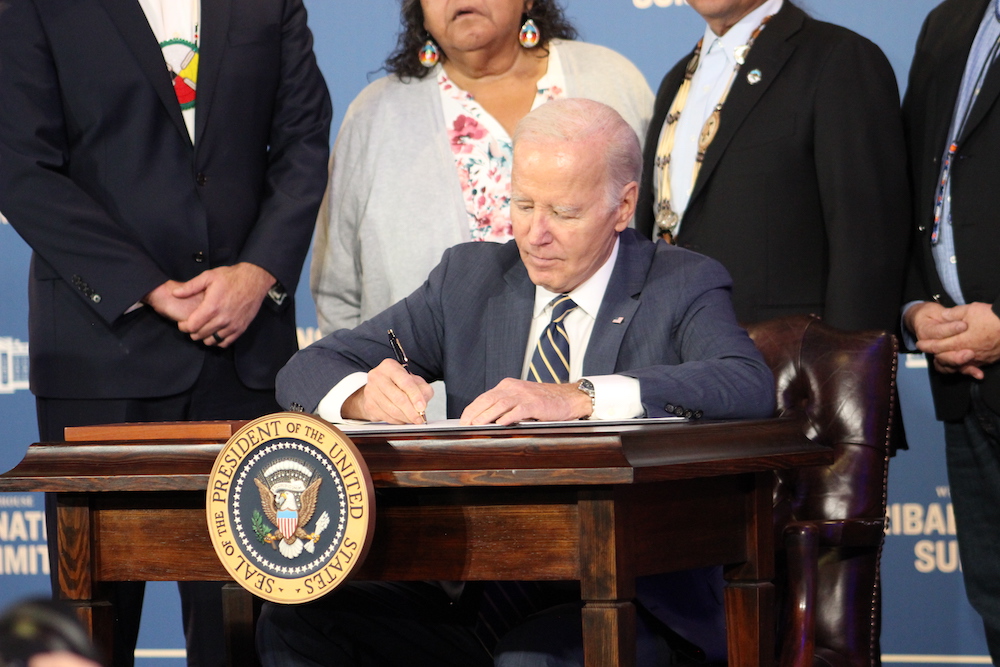
- Details
- By Levi Rickert
Opinion. December is an exciting time to be in Washington, D.C. The glittering lights of the National Christmas Tree and the 30-foot-tall National Menorah that stands on the northeast side of the Eclipse near the White House are beautiful to view. The excitement of the season is enhanced by the sounds of the holiday music playing in the majestic lobbies of the city’s hotels.
This week, I witnessed Washington's holiday splendor as I covered the Native CDFI Network’s annual policy summit, an important U.S. Department of Labor announcement, a Navajo Nation banquet, and the 2023 White House Tribal Nations Summit. These events featured distinguished speakers, including U.S. senators, House members, and cabinet officials.
The two-day Tribal Nations Summit hosted by the Biden administration and the Department of the Interior was the peak of a busy week for me — and many others. I saw many tribal leaders rushing between summit presentations and one-on-one meetings with federal officials that are a part of the nation-to-nation conversations that benefit tribes throughout Indian Country.
This year’s summit was the third of the Biden-Harris administration. The annual gathering of top officials and tribal leaders began during the Obama-Biden administration and ran for eight years in a row. There were no White House Tribal Nations conferences during the four years of the Trump administration.
Upon arrival this year, attendees were given an 81-page spiral-bound report called 2023 Progress Report for Tribal Nations. It is broken down into categories, such as homeland protection, energy, health, education, housing, and economic development, among others. The summit was filled with so much information Los Coyotes Band of Cahuilla and Cupeno Indians Chairman Ray Chapparosa jokingly said to me the summit was tiring him with “information overload.”
A high point of the summit came Wednesday afternoon when Biden spoke about his administration’s efforts to fulfill the federal government’s trust and treaty obligations to Indian Country.
“We’ve made progress, but we know Indigenous communities still live in the shadows of the failed policies of the past. That’s why — that’s why I committed to working with you to write a new and better chapter in American history for Indian nations,” Biden said.
Perhaps, the biggest prize from the summit was Biden’s executive order to expand tribal self-determination across the 574 federally recognized tribes. The order aims to make it easier for Native Americans to access federal funding and have greater autonomy over how to use the federal funds.
“Today, Tribal Nations still face many barriers to fully exercise their inherent sovereignty, especially in federal funding programs. Far too many of the federal funding and support programs that Tribes rely on are difficult to access, have overly burdensome federal reporting requirements, have unnecessary limitations, or impose requirements on Tribes that drain Tribal resources and undermine their ability to make their own decisions about where and how to meet the needs of their communities,” the executive order states.
With the intention to “promote compacting, contracting, co-management, co-stewardship” with tribes, the order several steps to make funding more accessible to tribes, including streamlining funding applications and reporting processes, allowing tribes to self-certify data when permitted by statute, and identifying funding programs that can support tribal set-asides.
The best news, perhaps, is that Biden’s executive order directs federal agencies to assess how federal funding has fallen short of meeting the federal trust responsibility owed to tribes and report their findings to the Office of Management and Budget (OMB) and the President. These reports will inform the development of the next President’s budget, which influences regular funding negotiations.
The work of the Biden-Harris administration has been instrumental in making positive progress in Indian Country. Interior Secretary Deb Haaland (Laguna Pueblo), the first Native American to ever hold a secretarial role within a presidential cabinet, has her fingerprints on much of the progress. Unfortunately, she was diagnosed with Covid-19 on Monday, making it impossible to participate in the summit in-person. However, she participated virtually, which allowed her to have her strong voice heard.
President Biden and Secretary Haaland realize there is still much work to be done to correct the decades–and arguably centuries–of neglect by the federal government to fulfill their treaty trust obligations to Indian Country.
So, beyond the glitter of the December holiday lights of Washington this past week, it was good for tribal leaders to leave with hope for a much brighter future for their tribal communities throughout Indian Country.
Thayék gde nwéndëmen - We are all related.
More Stories Like This
Extending the Affordable Care Act Is a Moral Imperative for Indian CountryAll Is Fair in … War?
Why Federal Health Insurance Policy Matters to Cherokee Nation
The Absence of October's Job Report Shows Why Native American Communities Need Better Data
Tribal IDs Are Federally Recognized. ICE Agents Are Ignoring Them.
Help us defend tribal sovereignty.
At Native News Online, our mission is rooted in telling the stories that strengthen sovereignty and uplift Indigenous voices — not just at year’s end, but every single day.
Because of your generosity last year, we were able to keep our reporters on the ground in tribal communities, at national gatherings and in the halls of Congress — covering the issues that matter most to Indian Country: sovereignty, culture, education, health and economic opportunity.
That support sustained us through a tough year in 2025. Now, as we look to the year ahead, we need your help right now to ensure warrior journalism remains strong — reporting that defends tribal sovereignty, amplifies Native truth, and holds power accountable.
 The stakes couldn't be higher. Your support keeps Native voices heard, Native stories told and Native sovereignty defended.
The stakes couldn't be higher. Your support keeps Native voices heard, Native stories told and Native sovereignty defended.
Stand with Warrior Journalism today.
Levi Rickert (Potawatomi), Editor & Publisher

